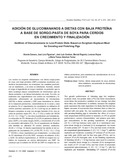Mostrar el registro sencillo del ítem
Adición de glucomananos a dietas con baja proteína a base de sorgo-pasta de soya para cerdos en crecimiento y finalización
| dc.rights.license | http://creativecommons.org/licenses/by-nc-sa/3.0/ve/ | |
| dc.contributor.author | Zamora, Vicente | |
| dc.contributor.author | Figueroa, José Luis | |
| dc.contributor.author | Cordero, José Luis | |
| dc.contributor.author | Rugerio, Marcial | |
| dc.contributor.author | Reyna, Lorenzo | |
| dc.contributor.author | Sánchez Torres, María Teresa | |
| dc.date.accessioned | 2010-05-27T20:56:48Z | |
| dc.date.available | 2010-05-27T20:56:48Z | |
| dc.date.issued | 2010-06-30 | |
| dc.identifier.issn | 0798-2259 | |
| dc.identifier.uri | http://www.saber.ula.ve/handle/123456789/31105 | |
| dc.description.abstract | Los cerdos en engorde alimentados con dietas sorgo-pasta de soya con baja proteína (DBP) presentan resultados productivos inconsistentes; en ocasiones, las variables productivas se mantienen, y en otras se deterioran. Además, siendo el sorgo el ingrediente en mayor cantidad, es probable que la dieta contenga mayor concentración de micotoxinas que en dietas estándar o en dietas formuladas con maíz. Por ello, se realizaron dos experimentos con cerdos en crecimiento y finalización, adicionando un secuestrante de micotoxinas (SECM) a dietas estándar y DBP para determinar su efecto en la respuesta productiva, características de la canal y urea en plasma. En el experimento de crecimiento se utilizaron 40 cerdos (machos castrados; 22,18 ± 0,82 kg) en un diseño de bloques completos al azar con arreglo factorial (2×4): dos niveles de proteína cruda (PC: 16; y 11,5%) y cuatro del SECM (0; 0,5; 1,0; 1,5 kg t ), con cinco repeticiones por tratamiento. La reducción de PC disminuyó (P±0,05) la ganancia diaria de peso (GDP) y de carne magra (GCM), e incrementó (P±0,05) la conversión alimenticia (CA). En el experimento de finalización también se utilizaron 40 cerdos (machos castrados; 49,48 ± 1,10 kg). El diseño experimental fue similar al del experimento de crecimiento (14 y 9,5% PC; 0; 0,5; 1,0 y 1,5 kg t SECM) y cinco repeticiones por tratamiento. La reducción de PC disminuyó (P±0,05) GDP, consumo de alimento (CAL) y GCM. En ambos experimentos, el SECM no mejoró las variables de respuesta en cerdos alimentados con DBP. Se concluye que la adición de SECM en DBP no mejora las variables productivas, pero mantiene las características de la canal, aunque reduce la GCM. | es_VE |
| dc.language.iso | es | es_VE |
| dc.publisher | SABER ULA | es_VE |
| dc.rights | info:eu-repo/semantics/openAccess | |
| dc.subject | Cerdos | es_VE |
| dc.subject | Dietas sorgo-pasta de soya | es_VE |
| dc.subject | Aminoácidos sintéticos | es_VE |
| dc.subject | Secuestrante de micotoxinas | es_VE |
| dc.title | Adición de glucomananos a dietas con baja proteína a base de sorgo-pasta de soya para cerdos en crecimiento y finalización | es_VE |
| dc.title.alternative | Addition of glucomannans to low-protein diets based on sorghum-soybean meal for growing and finishing pigs | es_VE |
| dc.type | info:eu-repo/semantics/article | |
| dc.description.abstract1 | The growth performance of fattening pigs fed sorghumsoybean meal, low-protein diets (LPD) has been inconsistent; some times the productive variables do not change, but other times they are deteriorated. In addition, because the sorghum grain represents the main ingredient, it is likely that the diet has higher amounts of mycotoxins than standard diets or diets formulated with corn grain. So, two experiments were conducted with growing-finishing pigs to determine the effect of a mycotoxin sequestrant (MSEQ) added to standard or LPD on growth performance, carcass characteristics, and plasma urea nitrogen concentration. In the growing experiment, 40 growing (22.18 ± 0.82 kg) barrows were used in a randomized complete block design in a factorial (2×4) arrangement: two levels of crude protein (CP: 16 and 11.5%) and four levels of micotixins sequestrant (glucomannans; 0, 0.5, 1.0, 1.5 kg t ), with five replicates per treatment. Lowering CP reduced (P 0.05) average daily gain (ADG) and fat free lean gain (FFLG), and increased (P 0,05) feed:gain ratio. In the finishing experiment, 40 finishing (49.48 ± 1.10 kg) barrows were used in a randomized complete block design in a factorial (2×4) arrangement: two levels of CP (14 and 9.5%) and four levels of micotoxins sequestrant (glucomannans; 0, 0.5, 1.0, 1.5 kg t ), with five replicates per treatment. Diminishing CP reduced (P 0.05) ADG, average daily feed intake, and FFLG. The addition of glucomannans to low-protein diets did not affect growth performance in both experiments. It was concluded that adding glucomannans as mycotoxins sequestrant does not improve productive variables in pigs fed low-protein diets, but it produces similar carcass characteristics as in pigs fed standard diet, except the lower FFLG. | es_VE |
| dc.description.colacion | 274-283 | es_VE |
| dc.description.email | jlfigueroa@colpos.mx. | es_VE |
| dc.description.frecuencia | Bimestral | |
| dc.identifier.depositolegal | 199102ZU46 | |
| dc.publisher.pais | Venezuela | es_VE |
| dc.subject.institucion | Universidad del Zulia (LUZ) | es_VE |
| dc.subject.institucion | Universidad de Los Andes (ULA) | es_VE |
| dc.subject.keywords | Pigs | es_VE |
| dc.subject.keywords | Sorghum-soybean diets | es_VE |
| dc.subject.keywords | Crystalline amino acids | es_VE |
| dc.subject.keywords | Glucomannans | es_VE |
| dc.subject.keywords | Plasma urea nitrogen concentration | es_VE |
| dc.subject.publicacionelectronica | Revista Científica | |
| dc.subject.seccion | Revista Científica: Producción Animal | es_VE |
| dc.subject.thematiccategory | Medio Ambiente | es_VE |
| dc.subject.tipo | Revistas | es_VE |
| dc.type.media | Texto | es_VE |
Ficheros en el ítem
Este ítem aparece en la(s) siguiente(s) colección(ones)
-
Revista Científica - 2010 - Vol. XX - No. 003
Mayo - Junio 2010


